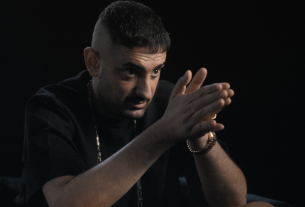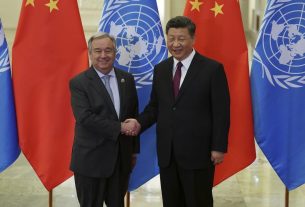A little over ten years after a boat carrying migrants from Libya to Italy sank off the coast of Lampedusa, claiming the lives of 368 migrants, another boat has capsized in the same waters, around 50 km off the coast.
Nine people perished, including a baby, after waves of up to 2.5 metres pushed over their frail vessel on 10 April. That same day, the European Parliament approved a landmark package of laws on migration and asylum, bringing an end to nearly a decade of negotiations and push-back from the far-right and left.
The EU’s far-reaching migration pact
The measures, of which many will come into force in 2026, mark the bloc’s biggest attempt yet to harmonise its policies on immigration.
Among key changes, the pact sets up border centres to hold people while asylum requests are processed. Via a screening procedure, including identification and fingerprinting, health, and security checks, it aims to provide a response to migrants within five days on whether they can stay or have to be deported.
With the bulk of the efforts falling onto the countries on the front line of migration, such as Italy, Greece and Malta, the pact aims to instil greater solidarity between EU member states. But rather than a compulsory quota of asylum seekers between members, it will now be voluntary. Countries would therefore have several options: relocations, financial contributions, or other solidarity measures, such as the deployment of personnel or logistical assistance to other countries.
When the Mediterranean became a graveyard
Throughout my career I have worn a number of hats. While currently a lecturer in public health at the University of Grenoble Alpes, I have also worked extensively in the humanitarian spheres, having served as the president of French humanitarian NGOs Action contre la faim (Action Against Hunger) and Médecins du monde (Doctors of the World), among others. I am an active member of the search-and-rescue NGO, SOS Méditerranée, responsible for Ocean Viking from September 2019.
I other experts fear the new laws will worsen the plight of migrants attempting to cross the Mediterranean, such as those who perished off the coast off Lampedusa on 10 April.
The pact comes after years of deterioration of the conditions in which rescue teams operate. On paper, the duty to search for and rescue shipwrecked persons does not lend itself to debate, be it international humanitarian law or in maritime law. According to Article 98 of the United Nations’ Convention of the Law of the Sea:
“Every State shall require the master of a ship flying its flag, in so far as he can do so without serious danger to the ship, the crew or the passengers… to render assistance to any person found at sea in danger of being lost.”
Yet from January 2014 to 2024, there have been an estimated 29,000 deaths in the Mediterranean Sea. Such figures have prompted Pope Francis to describe it as “Europe’s largest cemetery”.
Despite some good will, such as Italy’s short-lived “Mare Nostrum” humanitarian initiative in 2013, search-and-rescue teams operated by NGOs have had to contend with increasingly hostile EU member states over the past years. Indeed tales abound of rescue ships transporting migrants, sent to disembark thousands of miles away from their location. This was the case of Ocean Viking, chartered by SOS Méditerranée, in December 2023. Transporting 26 people, the ship was sent by Italian authorities to the port of Livorno, more than 1,000 km away, even though its services were severely needed during that period. Such detours generate significant costs for NGOs, with SOS Mediterranean estimating the bill of far-fetched ports at around 500,000 euros in 2023.
In addition, humanitarian rescue ships are regularly impounded by Italian authorities on the grounds that they strayed off set courses. This is yet again the case of Ocean Viking, which has been placed in administrative detention three times since last November.
How the pact could worsen migrants’ plight
The exchanges I was able to have with other experienced experts in international migration point to shared concerns.
For instance, Sylvie Guillaume, MEP for the SD Group, stated:
“While it is still difficult at this stage to establish precisely what the Asylum and Migration Pact will actually achieve, it is already clear that it will not solve the problems that the member states of the European Union are denouncing, nor most of the difficulties and violence encountered by migrants on their journey. It is silent on the imperative need to set up a search and rescue operation under European aegis, which would prevent the Mediterranean from continuing to be a huge graveyard.”
Guillaume describes the pact as a “terrible missed opportunity”. The senior vice-president of the European division of the International Rescue Committee (IRC), Harlem Désir, also agrees.
“The pact does not clarify the responsibilities of States in terms of rescue at sea, or support for the organisations that implement it and come to the aid of shipwrecked people,” he tells me. “It seems to forget the law of the sea. We can legitimately fear that States will continue to obstruct rescue operations, lengthen the route of boats, block them in ports and criminalise NGOs, making their action more difficult.”
Among the measures Désir lists, some are particularly likely to impact the lives of those who attempt to cross the Mediterranean. First, the pact establishes a system of detention for people arriving irregularly at the borders of the European Union – and potentially for all those who will subsequently be identified on the territories of the Member States.
Second, it is still unclear how states who do not wish to take in refugees will financially compensate for it. Also unclear are state’s responsibilities in terms of rescue at sea, or support for the organisations that implement it and come to the aid of shipwrecked people.
New Search and Rescue zones, new cemeteries?
The adoption of the pact comes after the EU struck migration agreements with two additional countries on the southern shores of the Mediterranean, which have thus been given crucial roles in controlling and stemming migration. In 2024, Egypt and Mauritania joined Turkey (2016), Libya (2017) and Tunisia (2023) in organising Europe’s anti-migrant defences. Despite this, the EU saw more migration in 2023, with 1.1 million asylum seekers and more than 350,000 irregular entries.
Questions and doubts immediately arose about the practices to be adopted by the two countries that have recently joined the relocated European system. From abuse, torture to human trafficking, violence of the worst kinds against migrants in Libya and Tunisia has been amply documented. The recurrent acts of violence by the Libyan navy against migrant boats intercepted at sea, and against NGO rescue ships, are also regularly denounced.
In 2018, Libya was given responsibility for a search-and-rescue (SAR) zone, which immediately caused problems for operations and the coordination of rescues at sea. The forthcoming allocation of identical responsibilities by the International Maritime Organisation (IMO) to Tunisia, Egypt and Mauritania could lead to a real cacophony in the overall organisation of rescue operations in the Mediterranean.
A number of would-be immigrants will want to bypass the reinforced filtering and detention systems. This will push them further into the shadows. As reported by Sophie Watt in the case of migrants crossing the Channel, this will expose them to even more violence from all sides in the transit countries, and to increased blackmail and manipulation by the networks of smugglers.
In the five partner countries of the European Union, we can expect smugglers to be subjected to greater pressure and stricter controls by the government authorities in the future. This, in turn, will only embolden them to financially blackmail migrants and worsen the conditions that they negotiate with those who are willing to remain candidates for a crossing at the price of all the dangers.



